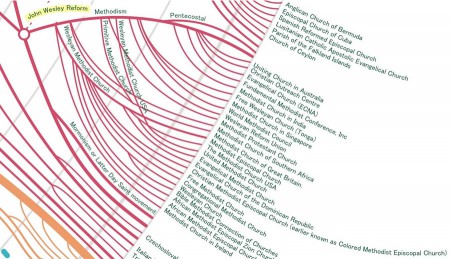
Via the Friendly Atheist, there’s a huge infographic that allows you to view a World Religions Tree that shows how each religion and its offshoots came about. It’s fascinating especially to see how the many branches of Christianity have interacted as compared with the other religions of the world.
For example, the Methodist branch stems from the John Wesley Reform. Here’s that segment, though I’m not sure of its complete accuracy (I don’t see the Evangelical United Brethren on that chart, for example). Regardless, you can see the myriad of churches and offshoots of the Wesleyan movement that came about, including Pentecostalism, from just one man. Amazing!
In fact, when you click on it and scroll to it, you see that the graphic claims that the John Wesley Reform was a convergence of two traditions: The Church of England AND a group I had never heard of called the Waldenses. What? Here’s some information about it. Some historians will have to explain that convergence to me.
So, a helpful resource for explaining the origins of many segments of faith traditions as well as to see how small a slice of humanity each “the true way” really has convinced in the grand scheme of faith.
Thoughts?



While an interesting info graphic, I think the Waldenses should have been the Moravians. I don’t really see the Waldensian connection and think it would have been better applied to the Moravians.
Also, do you have any idea why the John Wesley Reform seems to split off into Mornonism? I don’t see that connection at all.
Maybe because Joseph Smith (contrary to the “official” story) was a Methodist for a little while? As was Brigham Young, actually.
But I’d put them more under the umbrella of the “restorationist” movements. Like the Stone-Campbell Movement. At least, given the LDS restorationist claims, that’s probably the nearest relevant category.
Sound like “Valdenští”[1] In Czech. In French: vaudois. See Valdes de Lyon[2].
[1] https://cs.wikipedia.org/wiki/Valden%C5%A1t%C3%AD
[2] https://www.universdelabible.net/bible-et-histoire/les-reformateurs/133-valdes-de-lyon-1140-1217
I found this article while trying to look some more complex tree of history of churches. Is there a way to get the image in full resolution to publish it on my site?
The Waldensians predated Methodism. I knew they still existed under the “Reform” umbrella in Italy and surrounding areas. But I don’t know how much Methodism or John Wesley has historically drawn from Waldensianism. He drew more, of course, from Zinzendorf and the Moravians. In fact, according to the index of my “Works of Wesley,” John Wesley never mentioned Peter Waldo (whom the movement was named after.) Odd, if Wesley had drawn such inspiration from the Waldensians, no?
According to Wikipedia, Italian Methodism and the Waldensian Church came together in 1975. So I’d say that this infographic is simply not entirely accurate.
I think while helpful, this isn’t an exhaustive list (!) especially of Christianity. It’s crazy to think that we are more divided than that chart. For instance Pentecostalism could be it’s own branch with dozens of denominations. For instance the Christian and Missionary Alliance (1887) came out of the holiness movement (related to Wesley’s work in part) and the Assemblies of God came out of the C&MA (early 1900s), but then the C&MA wasn’t officially an denomination until 1912.
This is an astonishing piece of work. The detail is remarkable. I find it strangely comforting to see that other religions are almost as apt to sectarianism as Christians are. The Eastern religions have many more branches that I was aware of.
Jeremy, perhaps the reason the Evangelical United Brethren and its predecessor denominations aren’t shown is that there would be a spiderweb of interconnections on the chart. Through the EUB the UM Church has Mennonite, German Reformed, and Lutheran roots.
Though Wesley was ordained in the Church of England, both of his grandfathers were Puritan Dissenters whose independent thinking greatly influenced him, particularly as expressed through his mother Susanna. His theology was also heavily shaped by German Pietism through his contact with the Moravians, and his studies of the Patristics attracted him to the Eastern church’s teachings on theosis, giving shape to his understanding of sanctification.
I note both the Salvation Army and the Church of the Nazarene are not listed as derivatives from Methodism, and the entirety of Continental Reformed churches (and their North American branches) are absent from Calvinism.
Jeremy this is wonderful ! Regardless of a debatable detail here and there the overall image is awe inspiring and diverse and inclusive in the same glance !
We are all one race in the end, wouldn’t it be so wonderful if we could celebrate the diversity among us while acknowledging the God that is within us and who has created us all !
Be Blessed !
So….why does Arianism become a dotted line that goes all the way to the edge of the tree?
In an age of so much emphasis on Calvinism, I would like to introduce you to an Arminian exegetical ministry.I am an evangelical pastor and professor who has produced exegetical commentaries on the entire Bible. They are available free online in 48 languages. I am active in
1. E. Stanley Jones’ Ashram movement (approved teacher )
2. the John Wesley Methodist Seminary in Monterrey Mexico (visiting professor )
3. the OMS Emmaus seminary in Haiti (taught hermeneutics )
4. the interdenominational seminary in Nova Sod, Serbia
5. also taught at seminaries in Armenia, Russia
I hope you will take the time to evaluate the quality and quantity of my exegetical, verse by verse Bible studies free online.
Dr. Bob Utley
Professor of Hermeneutics(retired)
http://www.freebiblecommentary.org
http://www.BibleLessonsIntl.com
I can’t view that tree anymore. Please drop me new link on it. I was looking for one for a long time.